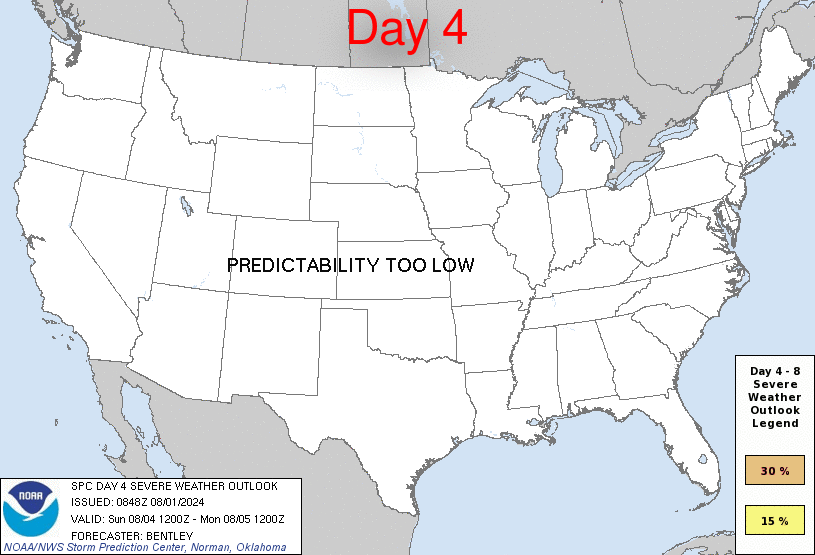NOAA Storm Prediction Center
Convective Outlooks
Convective Outlooks
The convective outlooks serve as guidance to the local NWS forecast offices and are used by emergency managers, private sector meteorologists, media, and other weather customers concerned with public safety. Three separate risk areas (slight, moderate, and high) are used to describe the expected coverage and intensity for the categorical severe weather threat on days 1-3 along with severe weather probabilities for the potential threat.
| Day 4-8 Severe Weather Outlook. A depicted severe weather area indicates a 30% or higher probability for severe thunderstorms within 25 miles of a point. |
| D4 | Mon, Apr 29, 2024 - Tue, Apr 30, 2024 |
D7 | Thu, May 02, 2024 - Fri, May 03, 2024 |
| D5 | Tue, Apr 30, 2024 - Wed, May 01, 2024 |
D8 | Fri, May 03, 2024 - Sat, May 04, 2024 |
| D6 | Wed, May 01, 2024 - Thu, May 02, 2024 |
(All days are valid from 12 UTC - 12 UTC) |
PREDICTABILITY TOO LOW is used to indicate severe storms may be possible based on some model scenarios. However, the location or occurrence of severe storms are in doubt due to:
- 1) large differences in the deterministic model solutions,
- 2) large spread in the ensemble guidance, and/or
- 3) minimal run-to-run continuity.
|
| POTENTIAL TOO LOW means the threat for a regional area of
organized severe storms appears highly unlikely during the entire
period (e.g. less than a 30% probability for a regional severe
storm area across the CONUS through the entire Day 4-8 period). |
Images courtesy of the NWS Storm Prediction Center
000
ACUS48 KWNS 260851
SWOD48
SPC AC 260849
Day 4-8 Convective Outlook
NWS Storm Prediction Center Norman OK
0349 AM CDT Fri Apr 26 2024
Valid 291200Z - 041200Z
...DISCUSSION...
A less amplified flow regime is expected to evolve through at least
early next week, with the strongest mid/upper-level westerlies
generally confined to the northern CONUS. However, a reservoir of
rich low-level moisture will persist across the southern Plains and
lower MS Valley, which may occasionally be drawn northward in
response to shortwave troughs moving through the primary belt of
westerlies. While no synoptically evident severe thunderstorm
episodes are currently apparent in extended-range guidance, some
threat could evolve each day through at least mid week.
...D4/Monday - Southern Plains into the ArkLaTex region...
Guidance generally suggests that a low-amplitude shortwave trough
will move across the southern Plains on Monday, though timing
remains somewhat uncertain. If the shortwave ends up being favorably
timed with the diurnal cycle, then a few strong to severe storms
will be possible from eastern portions of the southern Plains into
the lower MS Valley, with large hail and locally gusty winds likely
being the primary threats.
...D5/Tuesday - Great Plains into the upper Midwest...
Most extended-range guidance depicts a relatively strong shortwave
trough and attendant surface low moving across the northern Plains
on Tuesday. While stronger deep-layer flow/shear and large-scale
ascent will likely be displaced north of the more favorable
instability, a few strong storms could develop along the trailing
cold front somewhere from the central Plains into the upper Midwest.
...D6/Wednesday - Parts of the central/southern Plains...
The cold front that moves southeastward through the Great Plains
region on Tuesday will likely stall on Wednesday and potentially
move northward as a warm front, though guidance varies regarding the
placement of this boundary. Rich low-level moisture and moderate to
strong buoyancy will be in place along/south of the boundary during
the afternoon, and modest westerly flow aloft may be marginally
sufficient for a few strong to severe storms.
...D7/Thursday into D8/Friday...
There is some potential for a stronger cold front to move into parts
of the southern Plains and Southeast by the end of the week, though
spread in extended-range guidance notably increases at this forecast
range. If a stronger front does materialize, some strong to severe
thunderstorms could accompany the front, with generally dry and
stable conditions in its wake.
..Dean.. 04/26/2024


